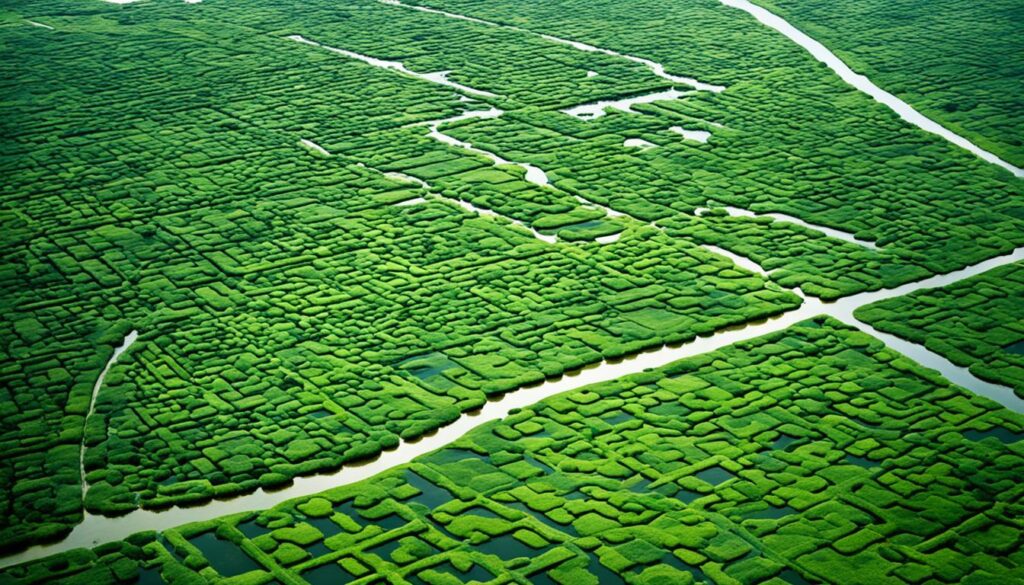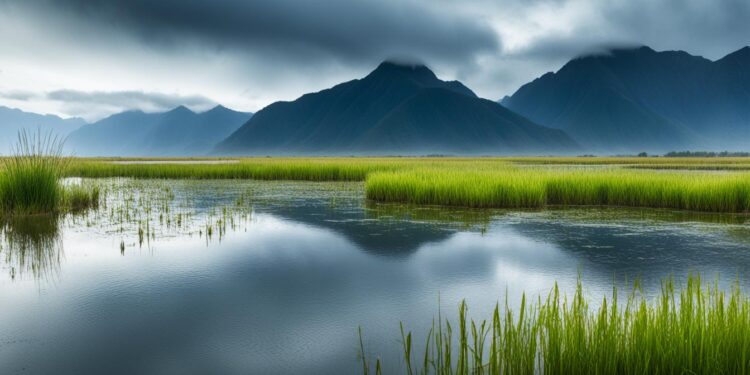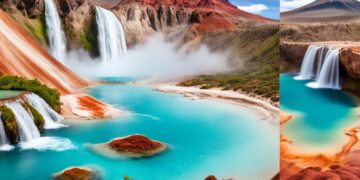Wetlands are amazing places full of life that help protect us from floods. They are often ignored but are key to fighting against floods. By learning how wetlands work, we can use nature to keep our communities safe.
Wetlands have plants, soil, and water that work together like nature’s sponges. They soak up extra water during heavy rains or snowmelt. This slows down floodwaters, giving areas time to get ready and lessen damage.
With more extreme weather happening, wetlands are more important than ever. But, they are being lost due to human actions like building and farming. Losing wetlands makes it harder to manage floods, putting communities at risk.
It’s vital to save and restore wetlands for our climate’s sake. Protecting these areas helps us fight floods and keeps our communities safe for the future.
What are Wetlands?
Wetlands are special places that are key to our planet’s health. They are lands that get a lot of water, sometimes all the time and sometimes just during certain seasons. These areas are full of different plants and animals. They also help humans and nature in big ways.
Defining Wetland Ecosystems
Wetlands are places where the soil is always wet, at least for some months. This wetness comes from rivers, lakes, oceans, and underground water. The water makes wetlands unique and important for many reasons.
Types of Wetlands
There are many kinds of wetlands, each with its own look and feel. Freshwater wetlands include swamps, marshes, bogs, and fens. Coastal wetlands are near the sea, rivers, and lakes. These places support a lot of life and help the people living nearby.
Wetlands, whether by water or sea, are crucial for our planet. They control water levels, clean pollutants, and are homes for many species. Knowing about the different wetlands helps us protect these vital places.
Nature’s Flood Control System
Wetlands are key to nature’s flood control. They soak up and store extra water during heavy rains or high water levels. This slows down floodwaters, preventing them from reaching downstream areas and protecting communities.
Wetlands are great at controlling water flow. They can hold a lot of water, lowering the flood risk in nearby places. This is super important in areas hit hard by storms and unpredictable weather.
The plants in wetlands help control floods too. Their roots and stems slow down water, breaking its force. This lets the water out slowly, reducing flood risks and helping groundwater levels.
Keeping wetlands safe helps communities use their flood control powers. This natural way to manage floods is cheaper and safer over time. It saves lives and property from flood damage.
Wetlands as Natural Sponges
Wetlands are amazing natural resources that help prevent floods. They can soak up and store a lot of water during heavy rain or floods. This makes them act like natural sponges.
Absorption and Storage Capabilities
The soil and plants in wetlands are crucial for soaking up and storing water. The soil acts like a sponge, holding a lot of water. This helps prevent flooding in nearby areas.
The plants in wetlands, like grasses and trees, slow down floodwaters. This gives the water time to soak into the soil. This natural setup is a great way to manage flood risks without spending a lot of money.
Wetlands are a key part of fighting against extreme weather and flooding. They absorb and store water, keeping communities safe. This approach is cheaper and more effective than building flood control structures.

It’s important to protect and restore wetlands to keep them working well. These natural areas are under threat from development and climate change. We need to value their role in managing floods and water.
Slowing Down Floodwaters
Wetlands are key in slowing down floodwaters, preventing damage. They have diverse vegetation that helps in this process. Grasses, shrubs, and trees in wetlands form barriers that reduce floodwaters’ energy and speed.
The Role of Vegetation
Wetland plants, with their deep roots and dense foliage, act like a sponge. They absorb and slow down floodwaters. This makes the waters spread out and lose speed, protecting areas downstream from damage.
Wetland vegetation, from grasses to trees, forms a strong defense against floods. Roots hold the soil, while leaves and branches trap debris and slow the water. This shows how wetlands are resilient and adaptable.
Wetlands slow down floodwaters, preventing erosion. This reduces soil loss and protects structures from flood damage. It’s crucial for preserving the land and infrastructure.
Coastal Wetlands: Barriers Against Storms
Coastal wetlands are vast areas of lush plants along oceans, rivers, and lakes. They are key to protecting our communities from storms and extreme weather. These natural barriers absorb wave and storm surges, protecting us from nature’s worst.
With climate change, coastal wetlands are more important than ever for storm protection. They act as our first defense against hurricane flooding, erosion, and sea level rise. By soaking up the impact of disasters, they help save homes, businesses, and important buildings.
Keeping these habitats safe is crucial for our communities. By working to protect and restore coastal wetlands, we help our communities stay strong against climate change. This can mean saving lives, property, and the health of our coastal areas.
As climate change makes the future uncertain, the role of coastal wetlands is clear. We must value and protect these natural barriers. Doing so helps ensure a resilient and sustainable future for all.
Wetland Loss and Flood Risk
Urban growth, farming, and building projects are taking over natural wetlands. This is causing big problems for communities. Wetlands are key in preventing floods, but losing them increases flood risks.
The Impact of Wetland Destruction
Wetlands soak up extra water during heavy rains or storms. But, destroying these areas harms the flood control system. Cities fill or drain wetlands for buildings and roads.
More land is being turned into farms, taking away wetlands’ flood-fighting ability. Climate change makes things worse, raising sea levels and causing extreme weather. This puts coastal wetlands at risk.
Without wetlands, floods hit harder, damaging homes, businesses, and roads. In some places, floods have forced people to leave because wetlands can’t protect them anymore.

We need to stop losing wetlands to fight flood risks. Wetlands are key in preventing floods. By saving and fixing these areas, we can lessen flood damage and keep our communities safe.
Restoration and Conservation Efforts
Wetlands are key to preventing floods, and a big push is on to save them. Government agencies, environmental groups, and local communities are all helping out. They see how important wetlands are for keeping floods away.
Restoring wetlands means making them work like they used to. This can mean taking out drainage tiles, breaking down levees, and putting back native plants. These actions help wetlands store water and filter it, and they also help animals.
Conserving wetlands is just as important. It means making laws and rules to protect them from harm. Things like buying land, making deals to protect it, and using land wisely are key. This keeps wetlands safe for the people who live nearby.
Wetland restoration and conservation are vital for fighting floods. By saving and fixing these areas, we use their power to stop floods. This protects our homes, businesses, and roads from big storms.
Sustainable Land Use Practices
As cities grow, we must balance growth with protecting nature. Sustainable land use practices help us find this balance. They are key to keeping our cities safe and green.
Balancing Development and Preservation
Urban planners and policymakers must walk a fine line. They need to plan for growth and protect nature. By using green infrastructure like wetlands and ponds, they can grow cities responsibly while keeping nature safe.
Keeping wetlands safe is vital. These areas soak up and hold floodwaters, helping to slow down the flow. By keeping these areas safe, we make our cities safer from floods.
Urban planners can also add green infrastructure to new projects. Things like wetlands and ponds can be part of the city, helping both people and nature.
By focusing on sustainable land use practices, we can make our cities better for everyone. This means keeping wetlands safe and using green solutions. It’s a way to make sure our cities are safe and green for the future.
The Economic Benefits of Wetland Preservation
Preserving and restoring wetlands brings big economic gains to communities. They help control floods, saving businesses and homeowners a lot of money. This is because wetlands can stop floodwaters from causing damage.
Wetlands soak up floodwaters like sponges. This means they can store a lot of water, preventing damage to buildings and roads. For example, one acre of wetland can hold up to 1.5 million gallons of floodwater. This makes them a smart way to fight floods.
Wetlands do more than just prevent floods. They clean and purify water, which cuts down on water treatment costs. They also are home to many animals, supporting tourism and outdoor activities. These activities help local economies grow.







